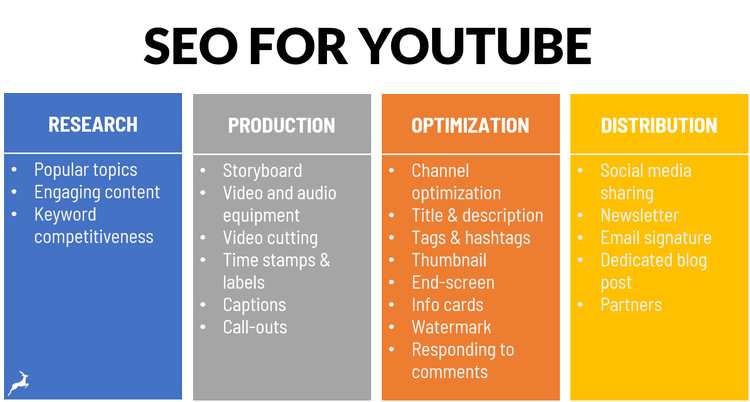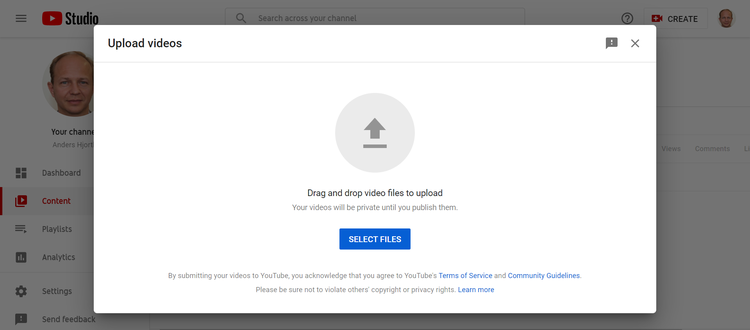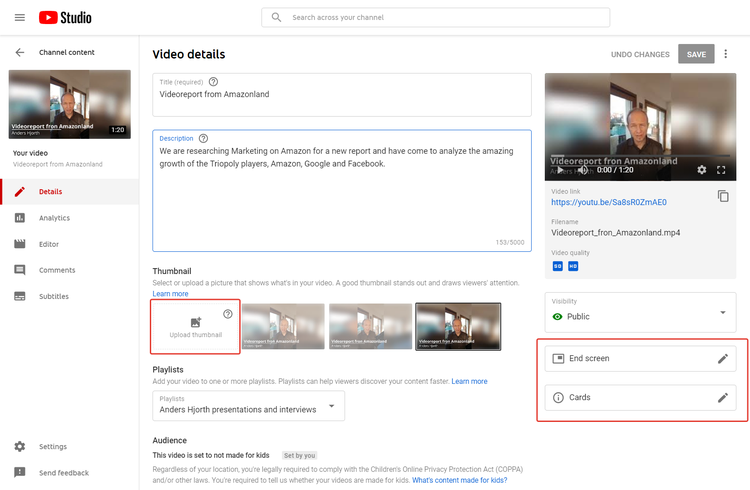YouTube is considered the second largest search engine in the world. After the mothership Google, of course. But it's also counted as the second-largest social media platform after Facebook. Is it a search engine or is it a social platform?
Search engines rank content on the basis of keyword relevance and popularity. Social media shows content based on quality, proximity, and time decay. On YouTube, there are elements of both.
SEO for YouTube is about generating views via the YouTube search engine but also via Google Search. It's different from traditional SEO because of the social media features of YouTube. Social media metrics such as connections and engagement can influence ranking.

SEO for YouTube requires a large number of actions spanning research, production, optimization, and distribution to generate results. Image source: Author
To go through a full YouTube search engine optimization process, we suggest the following steps. In some cases, the steps can be moved around, so you don't have to stick to the strict order.
1. Optimize your channel
Before starting your video project, it's a good idea to optimize your YouTube channel to make sure it's positioned right for your new topic and in itself is ready for SEO.
One of the most important things when you are working on SEO for a YouTube channel is to get the name and the URL right. Make sure the name is meaningful for your brand, your activity, or even the topic you are working on.
Once you are certain about the name, you can get a custom URL which is a great branding tool for your content. The catch is you need 100 subscribers to your channel to be able to create a custom URL, so you may not be able to do this from the outset.
2. Find your topic
You shouldn't underestimate the importance of the research phase for your video SEO. As engagement metrics and view-through rate influence visibility, your topic should be spot on user interest.
You can use a tool such as BuzzSumo to identify topics users engage with. With your topic in mind, keyword research can help you refine the idea and measure search volumes related to the topic.
Certain SEO tools can be used for both finding topics and finding the right keywords. A tool such as Ahrefs includes the YouTube search engine in its data sources.
3. Write your storyboard
You have found your topic and researched keywords around the topic. Now it's time to write your storyboard. Videos of 15 minutes perform well on YouTube. You can't improvise that.
In your storyboard, you can take inspiration from other videos on the subject, or analyze the structure of videos you like to watch. There's a good chance top ranking videos on any subject can inspire you to create a great storyboard.
People respond well to a classic storytelling layout where you define a key problem, build up momentum around it to reach a climax at around two thirds into the timeline. The last third of the video defines the solutions and details an action plan.
4. Define timestamps and labels
You can define chapters within your video, corresponding to specific subjects you talk about. These could correspond to some of the main keywords you identified in your research. You can insert a label at each timestamp.
From a technical standpoint, video chapters are defined after you publish your video, but from a planning perspective, results will be better if you plan them in your storyboard.
5. Shoot your video
The key moment of shooting your video has arrived. Creating great videos requires solid planning, great video and sound capture, as well as some post postproduction treatment.
My own setup for registering short video reports is the following:
- A recent smartphone for registering the video in high definition (HD)
- A light ring ensuring optimal lighting where the smartphone is fixed in the center
- A tie clip microphone to register high-quality audio
- An app named BigVu working as a text prompter, a simple video editor, and a caption generator.
Without counting the smartphone, the investment is less than $200 and well worth it for entry-level video capture.
Video optimization is important for SEO, but HD video works better. Use call-outs to encourage liking, sharing, commenting.
This is where YouTube reacts like a social network and favors engagement signals from its users.
6. Publish on YouTube
Publishing your video to YouTube is straightforward as long as you have a decent internet connection and aren't in a hurry. Avoid the nightmare of uploading a video from a mobile phone while on public transport. Been there, won't replicate.

Uploading the video is the easiest step in the video optimization process as long as you have a decent internet connection. Image source: Author
Most of the YouTube optimization happens after the video is fully uploaded and involves a number of optimization steps.
7. Create your titles, descriptions, tags, and hashtags
The first level of optimization is when you enter the title and description for your video. The title is more important than its keyword density, so don't overdo the focus on keywords here.
Make sure the description clearly and convincingly describes your video and includes the most important keywords in a natural manner. You can insert timestamps here, to help users find key parts of the video. And include clickable keyword-rich links in the description.
YouTube allows you to enter tags. These are really keywords that can help users find your video. They're primarily used for common misspellings and have little impact on ranking according to YouTube.
You can also enter hashtags for your video. These clickable tags appear above the title of a video. A click on a hashtag creates a search results page for the word. Selecting a few relevant hashtags can be a great guidance for users.
8. Create a custom thumbnail
YouTube automatically creates a thumbnail image for your video. But creating your own will generate better results. Taking control of the thumbnail allows you to choose an ideal visual and enter a short descriptive text or call to action.
Improving a thumbnail will increase the click-through rate (CTR) on the search result for your video and help it rank better.
9. Create captions and transcript
Subtitles are essential for videos, as a proportion of users look at videos with sound turned off. Many video apps can create the captions for you, and so can YouTube.
You can download the captions for use in a blog post later on in the SEO process. You can also change them and use them again on YouTube.
10. Build end-screen and info cards
An end-screen is a great way to finish a video on YouTube. It can be inserted separately when you edit a video. You can also insert information cards during the video to link to other videos.
End screens and Cards improve the user experience. This can extend the watch time and be an indicator of quality, and in this way help your video rank better.

End screens and Cards can be inserted in YouTube Studio after you uploaded the video. You can even return to edit these elements later. Image source: Author
11. Distribute via social media and more
Your video is now live and optimized on YouTube. You may know that search engines don't just look at the content of a page, and that off-page SEO is important for ranking.
The number of views, likes, comments, and shares your video receives is important for the ranking as well.
This is why you must systematically distribute and promote your videos on other platforms to gain momentum. First off, share the video on your social media assets. Pick the times when your audience is active, and consider tagging relevant people.
If you have a newsletter, make sure to link to your video in the next emailing. Also link to the video URL in your email signature. Perhaps you are a member of relevant social media groups where you can share the video link too.
The wider the distribution the better. As long as you make sure it's relevant to the audiences you distribute to and don't overdo it.
12. Distribute via partner channels
An often overlooked opportunity for creating traction for a YouTube video is with partners. The challenge is of course to find them. One way of doing this is to work with influencers. This typically comes at a cost but can be a great way to kick-start a channel or boost a freshly published video.
13. Respond and engage
Remember that YouTube is part social network. Users will like, comment, and share content on YouTube. Respond to all the comments and engage in discussions below your video.
There is also a fair bit of symmetric behavior. "I like your post, you like my post" and "If I comment on your video, will you comment on mine?"
If you find that people don't engage with your content much, a good way to start is to engage with other people's content, to fully understand the mechanisms.
14. Create a blog post
By now, you've hopefully gotten some traction for your video. To push it further you can now create a dedicated blog post on your site with the video embedded. You can use the transcript you extracted for content and embed the video.
The blog post will be a second opportunity to promote the video via your communication channels. Perhaps some users have subscribed to push notifications on your site or simply didn't see the original video link.
15. Monitor results
The first signs of success you will see are your YouTube statistics. If the video works well, there are better chances it will rank well too.
But it's also possible to monitor ranking in YouTube search with tools such as AccuRanker and Rank Ranger.
And finally, you may start seeing your video appear in video carousels for keyword searches on Google. You could also see your blog post appear in traditional search results.
About six weeks after the publication date, the time decay factor kicks in on YouTube. Your video is no longer considered fresh, and you risk not ranking as well. It will be time to publish a new one.
All-in-one search, social, and video optimization
Ranking with videos in YouTube and Google search requires an understanding of both search, social media, and video optimization. It also requires a lot of work, as we have illustrated with the 15 optimization steps spanning research, production, optimization, and distribution.
Thorough research and effective distribution are the most neglected areas in video SEO projects. Master those and you are well on your way to YouTube SEO success.
Our Small Business Expert
We're firm believers in the Golden Rule, which is why editorial opinions are ours alone and have not been previously reviewed, approved, or endorsed by included advertisers. The Ascent, a Motley Fool service, does not cover all offers on the market. The Ascent has a dedicated team of editors and analysts focused on personal finance, and they follow the same set of publishing standards and editorial integrity while maintaining professional separation from the analysts and editors on other Motley Fool brands.